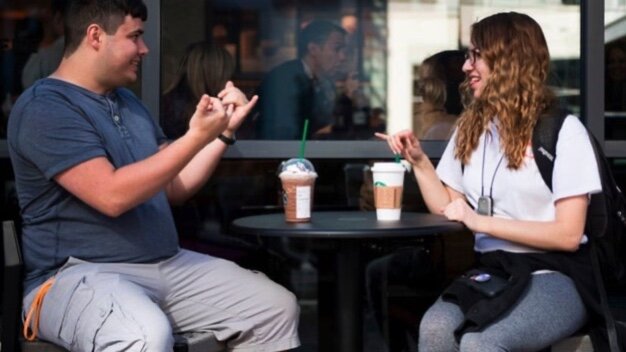Photo Source: Getty Images
When I was an Op-Ed Project Fellow, I wrote this opinion originally published in The Hill, a news website based in Washington, D.C.
Starbucks opened its first “signing store” in the U.S., where the staff are deaf or hard of hearing, sign language is an option and technology is available that makes the coffee experience accessible. Starbucks notes with pride that this is an opportunity to promote work opportunities for deaf people.
But how often do you think of deaf people as an asset? Negative attitudes and low expectations of what deaf people can do continue to lead to systematic exclusion from the opportunities, privileges and responsibilities of civic life. We see the impact of these attitudes every day:
1. Deaf students have not been prepared with the knowledge and skills that are needed to succeed after high school.
2. Deaf individuals are only half as likely to complete a bachelor’s degree, with gaps in some states reaching upwards of 25 percent.
3. A total of 48 percent of working age deaf adults are in the labor force, compared with 72 percent of working age hearing adults. Of those deaf adults not working, the vast majority has left the labor force all together.
The tragic irony is that, far from a liability and a population that needs to be “fixed” or tolerated, deaf people have unique experiences and perspectives that can benefit and be of value to an inclusive, hearing-dominant society.
Many hearing people have never met a deaf person who has had to overcome the significant barriers to success.
There are relatively few individuals who are deaf or hard of hearing from birth: only one in approximately 100 children who receive special education services in the U.S. are identified with hearing loss as their primary disability.
The lives of people growing up as deaf or hard of hearing are different in important ways than veterans who may have combat-related hearing loss or seniors who lose some or all of their hearing late in life. Deafness is a way of being that, with its rich linguistic and cultural norms, focuses on use of visual means of communication and an innovative approach to solving complex problems.
While we may see sign language interpreters on television during major emergencies such as a hurricane or terrorist attacks, the vast majority of spoken information is not accessible to those with significant hearing loss. The Americans with Disabilities Act and its amendments established a legal right for all individuals with disabilities, including deaf people, to have the right to access to information and opportunities. Unfortunately, the deaf people face access barriers even with the legal rights assured under ADA.
Those unfamiliar with the experience of deaf people may take for granted the ease with which hearing people navigate their everyday lives. Start to see the world through the eyes of a deaf person. When you open a video on face book, is it captioned? When you go visit a doctor and ask for an interpreter, do you get turned away because they do not wish to cover the costs for access? When there is a gate change or flight delay at the airport, are you also notified of these changes?
Many will argue that the financial costs of including deaf people are too much for our institutions to bear. A deaf person is often seen as more expensive than those from other disability groups or their hearing peers.
An interpreter or caption provider can cost anywhere from $40 to over $100 per hour, depending on the location and technical expertise of the situation. These are ongoing costs of access that cannot be solved by a one-time expense such as building a ramp or adding braille to store signage.
This mindset masks what are the very real costs of not providing access services for deaf people. An underemployed labor force affects not only deaf people but their families and communities as well. The attitude of “it’s too much” and persistent denial of access services across all walks of life renders deaf individuals unable to fully contribute to the good of society, including its financial health. Approximately 12 percent of individuals between the ages of 25 and 64 with hearing loss receive federal support from SSI.
With high expectations and access to communication, deaf people can be successful. Consider the NFL Running Back Derrick Coleman, formerly of the Seattle Seahawks, currently with the Arizona Cardinals. President Obama’s receptionist, Leah Katz-Hernandez, was also deaf. Nyle Dimarco, a deaf actor and model, recently won not only America’s Next Top Model, but also Dancing with the Stars. Millicent Simmons, the young deaf actress in A Quiet Place and Wonderstruck, has reclaimed a long-empty space for deaf representation in major motion pictures.
Yet, these gains are fragile. The hashtag #deaftalent is a point of pride but also a point of protest: Hearing people are still cast in the roles of deaf people, taking crash courses in sign language so that they can “pass” as a deaf character.
This is a form of black face that represents how our society views deaf people as not only not hearing, but without value even in their own deaf identities.
So the next time you go have a cup of coffee and order your daily caffeine fix, remember two things. First, that deaf people have important contributions to make that benefit society as a whole. Second, that the tyranny of low expectations and denial of access to even basic services holds back yet another generation of deaf people from achieving their goals. Learn to see the world through our eyes.


